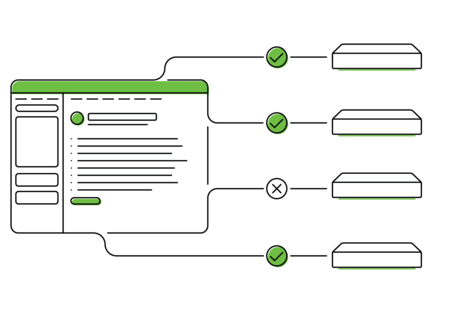How to Deploy Solstice
The Solstice Pod
The Solstice Pod attaches to the display in the room to enable multiple users to wirelessly connect and share content from their laptops and mobile devices over the WiFi/Ethernet network(s).


User Devices
Solstice allows users to connect and share content from their Windows, Mac OS, Android, and iOS devices by downloading the free Solstice app. Once they have the app, users can take advantage of Solstice’s intuitive user interface and powerful collaboration features, including multiple sharing options, layout control, and more.
Display
The Solstice Pod connects to any display with an HDMI input, allowing you to leverage your existing AV infrastructure. Have touch displays? Solstice supports most HID touch screens.


Network
Solstice is designed to be flexibly deployed on the existing IT network to enable users with network access to connect and collaborate. Have a separate guest network? Solstice supports dual-network deployment to provide both guests and users on the primary network the ability to connect and collaborate securely in the same meeting. In the dual-network configuration, the Pod’s two network interfaces operate independently using separate routing tables and maintaining a firewall between the two networks. Solstice uses TCP/IP routable network traffic which can be configured for multiple subnets or VLANs and to comply with security-sensitive environments.
Solstice Cloud
Solstice Cloud software is a cloud-based management portal that can be used to monitor, configure and update Solstice Enterprise Edition Pods. Solstice Cloud allows IT administrators to remotely manage larger deployments of Solstice and provides access to scheduled software updates, meeting space analytics, and more.


Solstice Dashboard
For organizations who are unable to use Solstice Cloud, the Solstice Dashboard is on-premises centralized management tool that can be used to monitor, configure and update Solstice Enterprise Edition Pods and Windows Software instances on a network. Solstice Dashboard allows IT administrators to manage larger deployments of Solstice from a central, on-premises location.
Solstice Discovery Service
SDS is a free, non-broadcast alternative to the Solstice default broadcast discovery mechanism. SDS allows users to discover and click-to-connect to Solstice displays from their own devices without the use of UDP broadcast/multicast traffic. If neither SDS nor broadcast discovery is enabled, users will be required to enter Solstice display IP addresses each time they want to connect a Solstice display and will not be able to utilize Solstice’s one-step meeting start.


OpenControl API
The OpenControl protocol is a RESTful API supports third-party integration with Solstice Enterprise Edition Pods. OpenControl can be used to read the status of a Solstice Enterprise Edition Pod, capture usage statistics, and configure Solstice Enterprise Edition endpoints. The examples in our guide are shown in Python 2.7, but any language that can issue GET and POST commands may be used.